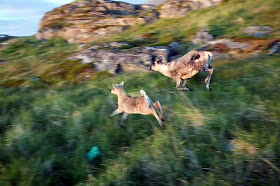As for me, red is like the winter sunshine on my face.
Red...
feels warm like velvet
tastes strong like vodka
sounds merry like the Xmas jingle bells



The coo, hoot, twitter and chirp of birds from the back yard. The distant grind and groan of a car. The strident shouts, cries and chatter of children on the playground. The steady hum from the refrigerator in the kitchen. The pounding, heavy footsteps from the staircase in my walk-up apartment building. The unidentified snorts, laughter, bangs, honks, squeaks, creaks and whistles.
Twenty minutes latter, I opened my eyes. I stretched my body, and I heard a voice in my mind: more practice, and bigger ears, I could get to hear a ginkgo leaf falling on the sidewalk of Mott street in NoLiTa.
 New York Downtown Style: Chinese version vs. Taiwanese version
New York Downtown Style: Chinese version vs. Taiwanese version 

It's known that music can respond and appeal directly to an artist's "internal element" and express spiritual values. On writing, the French poet Charles Baudelaire affirmed that "scents, colors and sounds answer one another". On painting, the Russian artist Wassily Kandinsky had this to say:
"Color is the keyboard, the eyes are the harmonies, the soul is the piano with many strings. The artist is the hand that plays, touching one key then another to cause vibration in the soul. It is therefore evident that color harmony must rely only on a corresponding vibration in the human soul."
If scent is the music for our nose, color is the music for our eyes.
I don't have a good ear to listen, but I appreciate music. Music allows me a freedom of imagination, interpretation, and emotional response on my design. I especially feel attracted to Bach, whose works are greatly admired for their intellectual depth, technical command and artistic beauty.
While working, I like to play Bach's music. I often picture myself walking through fields of paper, touching it with my pencil as if I'm composing the most enchanting music. To me, the organic and geometric shapes that I draw on my sketchbook are like Bach's musical notes that tangle with my joy and happiness.
I was enthralled by Kandinsky's curious gift of colour-hearing (synaesthesia), which he successfully translated onto canvas as "visual music". His artistic ambition got me thinking that, as a designer without the capacity to see sound and hear color, how I can conjure a visual presentation of music that illustrates the affinities between shapes and colors?
Therefore, I crabbed my pencil and started my musical adventure: I drew circles, triangles, and squares, one by one, and filled them in colors. Then, I made them sing with all the intensity I could to create a perfect visual harmony...
My dear readers, this is the creative process of this poster design that I pay homage to Kandinsky. Before you leave let me ask you. Do you hear my design?



 Ambiguity is the hallmark of Kenzaburo Oe (大江 健三郎), Japan's second Nobel Laureate in Literature. He defines ambiguity as “vague, obscure, equivocal, dubious, doubtful, questionable, shady, noncommittal, indefinite, hazy, double, tow-edged”. In Japan, aimai (Japanese: ambiguity) permeates art, culture, literature and even the language.
Ambiguity is the hallmark of Kenzaburo Oe (大江 健三郎), Japan's second Nobel Laureate in Literature. He defines ambiguity as “vague, obscure, equivocal, dubious, doubtful, questionable, shady, noncommittal, indefinite, hazy, double, tow-edged”. In Japan, aimai (Japanese: ambiguity) permeates art, culture, literature and even the language. I like to hang out alone at the Strand Bookstore in lower Manhattan. Although Strand is well known as one of the busiest bookstores to entice the crowd of book bargainer hunters, I find that loitering around the congested passageways between its imposing shelves is peaceful and quiet. I appreciate the chance of being away from computers and conversation, and taking pleasure in a single activity – browsing the shelves for good book cover designs. As Strand call themselves the home of 18 miles of books, there are sure to be some hidden treasures.
I like to hang out alone at the Strand Bookstore in lower Manhattan. Although Strand is well known as one of the busiest bookstores to entice the crowd of book bargainer hunters, I find that loitering around the congested passageways between its imposing shelves is peaceful and quiet. I appreciate the chance of being away from computers and conversation, and taking pleasure in a single activity – browsing the shelves for good book cover designs. As Strand call themselves the home of 18 miles of books, there are sure to be some hidden treasures.










